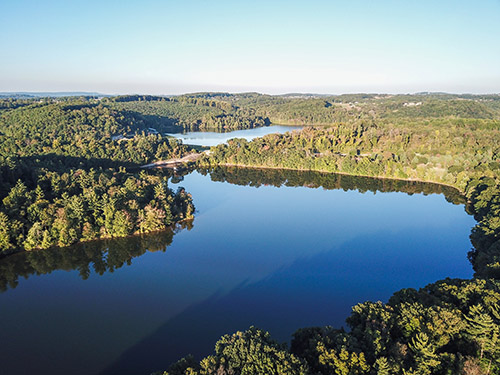One of the great things about living in Pennsylvania is that easy access to waterways can make them feel like part of our personal lives. For many of us, there’s nothing better than having the boat out on the water or pedaling a riverside bike trail. Maybe you and the kids have a favorite fishing spot and good memories of fishing trips with the grandparents. You might have the kayaks and tubes out all summer. A stream may run through your private property, or a waterway may be a popular part of a community park your municipality maintains.
If you see a particular stream, river, or lake as a special part of your Pennsylvania life, the best thing you can do is to broaden your focus and remember it’s connected to thousands of miles of waterways and land in the watershed you live in.

A new DEP storymap,
Healthy Waters, Healthy Communities, shows how a watershed is a highly functioning natural system that benefits Pennsylvanians daily. Although the storymap addresses our sizable (43 counties) share of the Chesapeake Bay Watershed, it’s a great learning opportunity for all Pennsylvanians on how watersheds work and the pollution challenges they face.
In addition to unparalleled recreation experience, a healthy watershed provides a pretty amazing range of other benefits. It enables the agricultural and outdoor recreation industries that employ thousands of Pennsylvanians and provide billions to our economy. It provides healthy soil for better crops, reduces flooding, helps slow climate change, provides habitat, can reduce energy use, can increase business and protect property value, and improves our lives in other ways outlined on the storymap.

But over 12,000 miles of waters in Pennsylvania’s share of the Chesapeake Bay Watershed have been degraded by runoff pollution. This is the nitrogen, phosphorus, and sediment pollution that, instead of filtering into the ground during a rainstorm, washes off farm fields, overfertilized turf, and roads and other hard surfaces and goes right into our waterways. After a hundred years of development, runoff is the pollution from everyone, everywhere. It’s slowly but steadily taking the oxygen out of streams, rivers, and lakes, making them less and less a resource for people and wildlife.

“Healthy Waters, Healthy Communities” identifies specific actions, small and large, that farmers, municipal leaders, business owners, and residents can take to lighten the load of runoff pollution in our waters.
You can help your favorite stream, for example, by planting native trees or putting fencing along the bank. Programs from DEP, the Department of Conservation and Natural Resources, and the Department of Agriculture that provide funding and technical know-how for runoff pollution reduction measures are noted throughout the storymap.
If you’d like to help at the community scale, “Healthy Waters, Healthy Communities” connects you to your Countywide Action Plan and to organizations that’d be happy to get you involved as a volunteer in local projects. There’s even a link to search for volunteer groups by zip code.

For formal and nonformal educators, the storymap shares information on Meaningful Watershed Education Experiences and other tools, and a Northeastern School District science teacher talks about how streambank plantings grow students as well as trees.
Reducing water pollution that has no boundaries is a challenge across the United States. But Pennsylvanians are becoming aware of the cost that unhealthy streams and rivers have for our quality of life and livelihoods. They’re taking actions on their farms, in their communities, and at their businesses and homes. Meet a few of them on the storymap:
- Lycoming County beef cattle farmer Michael Sherman saw his cattle benefit after he planted trees and other vegetation on a streambank, provided off-stream watering, and put other water conservation measures in place.
- Eleven Blair County municipalities are partnering on several stormwater management projects, starting with a large rain garden that school students and community volunteers planted in Altoona.
- The City of Lancaster is pioneering an innovative 10-year plan to replace gray infrastructure with green infrastructure to manage stormwater runoff more effectively and for less cost.
- York County homeowner Tom Smith turned his entire one-acre suburban yard into a bioswale and raingarden that filter runoff pollution and reduce flooding from 27 surrounding acres. Seeing 60 species of birds is a bonus.
And be inspired. If you value what your local stream, river, or lake adds to your life, learn what you can do to keep it alive at
Healthy Waters, Healthy Communities.